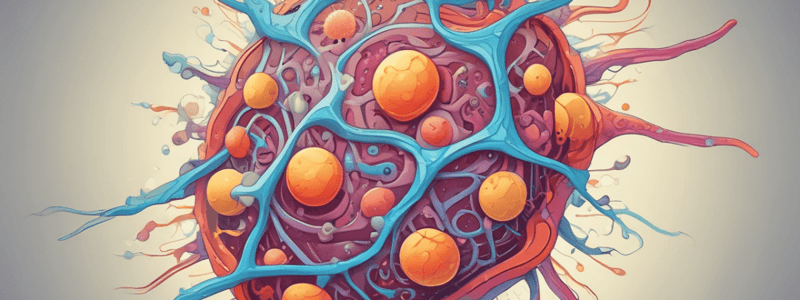Podcast
Questions and Answers
What is the primary outcome of cell injury?
What is the primary outcome of cell injury?
- Disruption of cell homeostasis or steady state (correct)
- Reversible adaptation
- Stimulation of cellular growth
- Immediate death of the cell
Which of the following is NOT a common cause of cell injury?
Which of the following is NOT a common cause of cell injury?
- Immunological dysfunction
- Hormonal imbalance (correct)
- Infectious agents
- Oxygen deficiency
What is the term for the partial reduction in O2 delivery to a tissue?
What is the term for the partial reduction in O2 delivery to a tissue?
- Hypoxia (correct)
- Anoxia
- Oxygenation
- Ischemia
What is the result of a cell's inability to maintain internal equilibrium by adjusting its physiological processes?
What is the result of a cell's inability to maintain internal equilibrium by adjusting its physiological processes?
What is the term for the ability to maintain internal equilibrium by adjusting physiological processes?
What is the term for the ability to maintain internal equilibrium by adjusting physiological processes?
Which of the following is a mechanism of cell injury related to the loss of cellular structure?
Which of the following is a mechanism of cell injury related to the loss of cellular structure?
What is the primary source of Reactive Oxygen Species (ROS) during normal cellular respiration?
What is the primary source of Reactive Oxygen Species (ROS) during normal cellular respiration?
Which of the following molecules is NOT a Reactive Oxygen Species (ROS)?
Which of the following molecules is NOT a Reactive Oxygen Species (ROS)?
What is the result of excess ROS or decreased scavenging capacity?
What is the result of excess ROS or decreased scavenging capacity?
Which of the following is a source of ROS production during inflammation?
Which of the following is a source of ROS production during inflammation?
What is the product of the reaction between water and ionizing radiation?
What is the product of the reaction between water and ionizing radiation?
Which transition metal can donate or accept free electrons, catalyzing free radical formation?
Which transition metal can donate or accept free electrons, catalyzing free radical formation?
What is the result of the fusion of phagocytic vacuoles with lysosomes during phagocytosis?
What is the result of the fusion of phagocytic vacuoles with lysosomes during phagocytosis?
What is the function of antioxidant vitamins such as Vitamin E and Vitamin A?
What is the function of antioxidant vitamins such as Vitamin E and Vitamin A?
What is the result of the reaction between superoxide and water?
What is the result of the reaction between superoxide and water?
What is the role of myeloperoxidase (MPO) in phagocytosis?
What is the role of myeloperoxidase (MPO) in phagocytosis?
What is the consequence of increased production of reactive oxygen species (ROS) in response to injurious stimuli?
What is the consequence of increased production of reactive oxygen species (ROS) in response to injurious stimuli?
What is the function of enzymes such as catalase and superoxide dismutase?
What is the function of enzymes such as catalase and superoxide dismutase?
What is the primary mechanism by which free radicals are removed from cells?
What is the primary mechanism by which free radicals are removed from cells?
What is the effect of lipid peroxidation on cell membranes?
What is the effect of lipid peroxidation on cell membranes?
What is the consequence of oxidative modification of proteins?
What is the consequence of oxidative modification of proteins?
What is the location of monamine oxidase (MOA) that generates oxidative stress?
What is the location of monamine oxidase (MOA) that generates oxidative stress?
What is the result of increased phospholipid breakdown in cells?
What is the result of increased phospholipid breakdown in cells?
What is the consequence of mitochondrial membrane damage on ATP levels?
What is the consequence of mitochondrial membrane damage on ATP levels?
What is the primary function of Alanine aminotransferase (ALT) in hepatocytes?
What is the primary function of Alanine aminotransferase (ALT) in hepatocytes?
What happens to the cell when the plasma membrane is damaged?
What happens to the cell when the plasma membrane is damaged?
What is the consequence of lysosomal membrane injury?
What is the consequence of lysosomal membrane injury?
What is the purpose of measuring Alanine aminotransferase (ALT) levels in a biochem panel?
What is the purpose of measuring Alanine aminotransferase (ALT) levels in a biochem panel?
What is the result of reperfusion of ischemic tissues?
What is the result of reperfusion of ischemic tissues?
Flashcards are hidden until you start studying




